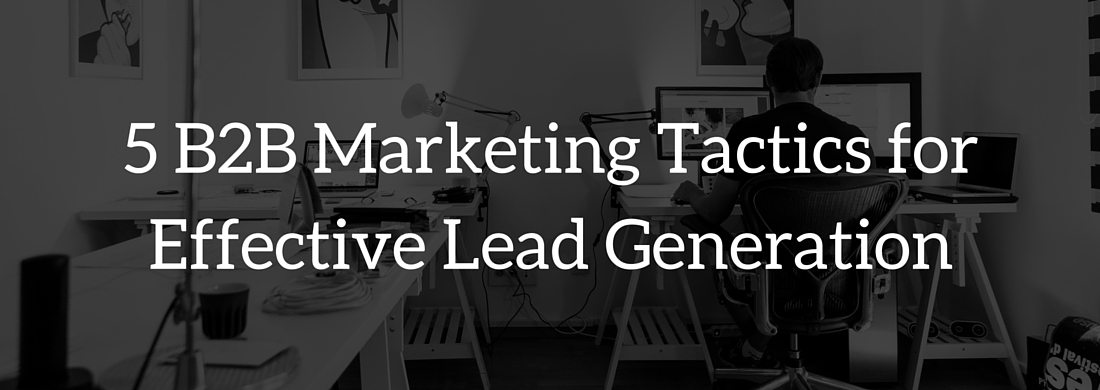
14 Sep 5 B2B Marketing Tactics for Effective Lead Generation
How do you generate leads in a world where getting the attention of buyers is getting harder and harder?
The answer: testing channels in a way that’s incredibly value-driven and highly targeted.
You know there are many channels you should be testing and new B2B marketing tactics you could be trying out. The question is which are worth focusing your attention on?
Not all marketing channels are made equally, and some are certainly more effective than others. That’s why I’ve listed out 5 of the most effective tactics you can test out right now.
Paul Graham once said “do things that don’t scale”. It applies mainly to startups but should be adopted by marketing teams of all sizes:
“A good metaphor [for doing things that don’t scale] would be the cranks that car engines had before they got electric starters. Once the engine was going, it would keep going, but there was a separate and laborious process to get it going.”
When trying out new marketing channels or techniques it’s best to first test on a small scale in a way that requires manual effort.
This article will help you to get started with these 5 marketing tactics. You implement now and look back after 30 days of testing to see if they’re worth pursuing further, scaling up or automating.
These B2B marketing tactics are at the forefront of the industry right now. They have already been tested by many organisations with great success. There’s no fluff here, only what’s working right now.
Tactic 1: Build Interactive Content
As the popularity of content marketing in the forms of eBooks, blog posts and whitepapers increases, marketers need to be more intelligent to cut through the noise.
That’s not to say these forms of content no longer work. But it needs to be exceptional for it to actually work.
One way to create high-value content is to build interactive content. What do I mean by this? It’s likely you’ve seen a BuzzFeed quiz or some sort of “personality assessment” shared on Facebook and other social networks recently.
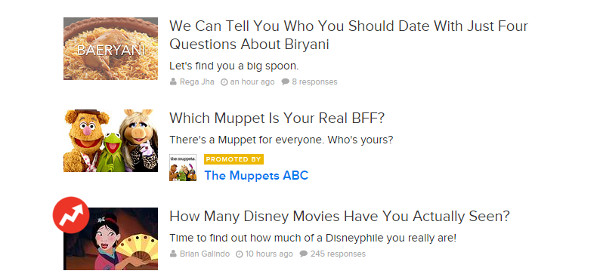
This is a great example of B2C marketing, but the benefits of B2B-focused interactive content include:
- Increased engagement on your site and with your brand in general
- Lower bounce rates
- Higher conversions from traffic to leads
Let’s explore some forms of interactive content as well as some examples from other brands.
Supercharging Your Whitepapers & eBooks
As I said, eBooks and other forms of content work great, but they’re still a fairly static form of content. Not a great deal has changed save for some design and social sharing mechanisms.
The other problem that they present is that, although we can measure who downloads them, we can’t be sure who reads them.
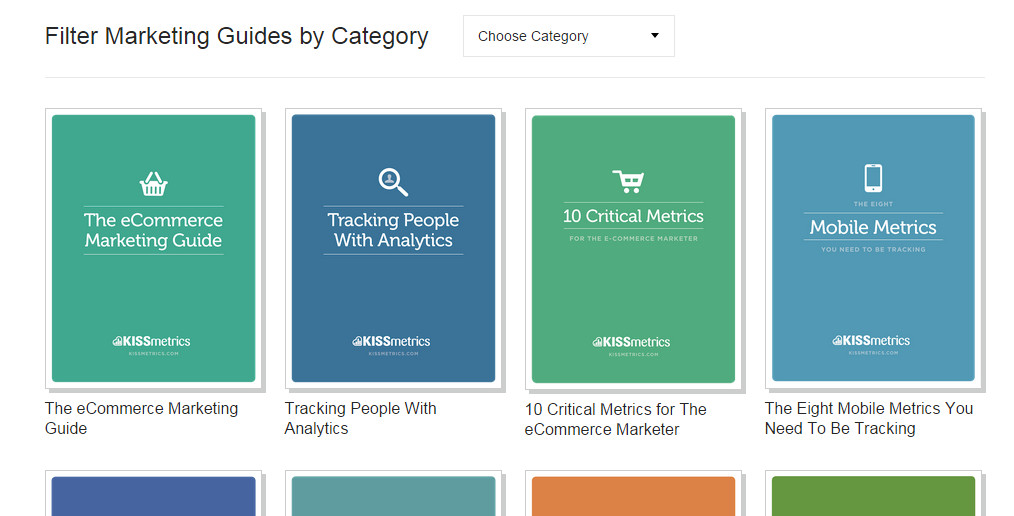
Supercharging your content to make them interactive makes it far more engaging, interactive and gets the reader involved. You can add multimedia and an element of gamification that will keep your audience around for longer and lead to more engagements.
Many marketers feel intimidated at the idea of creating interactive content due to the perceived development costs, but there are already several tools out there than can create content quickly and easily.
For interactive eBooks you can use a tool called Guides.co to easily create interactive, well, guides:
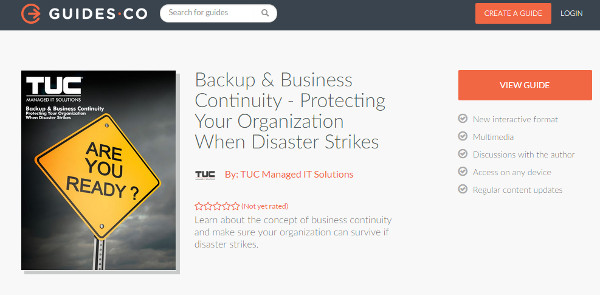
With Guides.co, you can “guide” your audience step-by-step through your content with actions, images, video and other forms of media. The aim of the game is to increase engagement, get your leads involved in the content and lead them further down the funnel by having them interact and commit.
Multi-Purpose Quizzes
If you’ve been on Facebook for more than a minute you’ve likely seen links to quizzes, most of which are hosted on BuzzFeed. “Which Harry Potter character are you?” and “How Many Of These Traditional British Desserts Have You Tried?” are but some obscure examples.
These do sound fun, but how do we apply them to a B2B perspective?
Surveys and quizzes are incredibly useful to gather the perspective, challenges and needs of your audience. What they can also do is optimise your buyer personas with more granular and up-to-date information.
With assessments you can see how different job roles rank themselves. Quizzes can shine a light on which topics your audience need more help with.
You can easily create quizzes, surveys and other forms of content that offer multiple-choice answers with a tool called ContentTools:
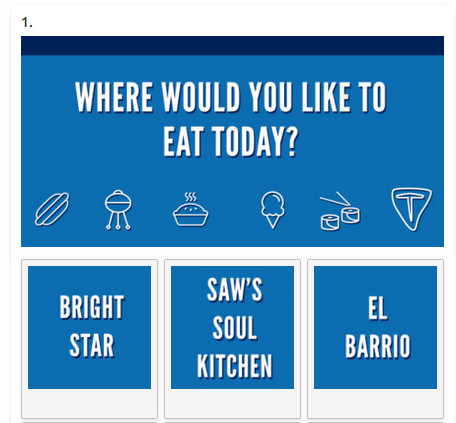
Not only can you create quizzes and surveys but also rankers and contests, too. Check out their full list of features to get the full view of what you can create.
Interactive Infographics
We all know that infographics are one of the most shareable content assets you can create. How can you take an already successful medium and make it even better?
By making them interactive.
Infographics are usually a rich source of statistics and insights on various topics. By making certain elements interactive you can allow your users to expand certain topics areas to unveil even more information.
Again, development resources are often an issue, especially when it comes to testing. To begin testing interactive infographics on a small scale, you can use a tool like Ceros.
With it, you can add video and other interactive elements to make the infographic more dynamic.
3 Interactive Content Examples
Now you have three different forms of interactive content you can begin testing. Although this is a good start, it’s always helpful to see some in action.
Encidia created a quiz so their audience could calculate how much they could save on package returns. The result was a higher level of engagement and a boost in leads:
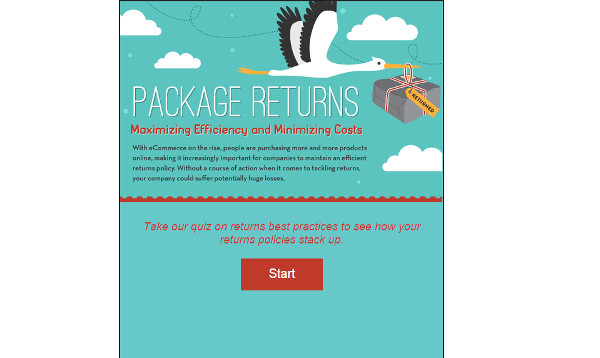
NetProspex created an interactive guide on record completeness as part of their “State of Marketing Data”. Leads can rank how they do in each of their best practice areas and get a grade.
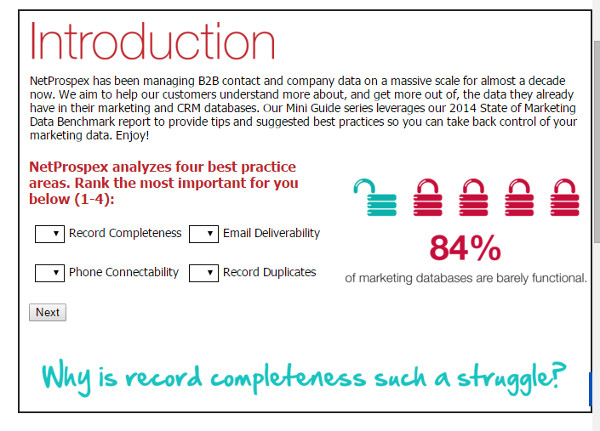
This eventually leads to a call-to-action asking the user to download a report. It takes the quiz format and puts an interactive spin on the opt-in process.
Finally, SilkRoad Technology created an ROI calculator for their audience to calculate how much they could save with onboarding technology:
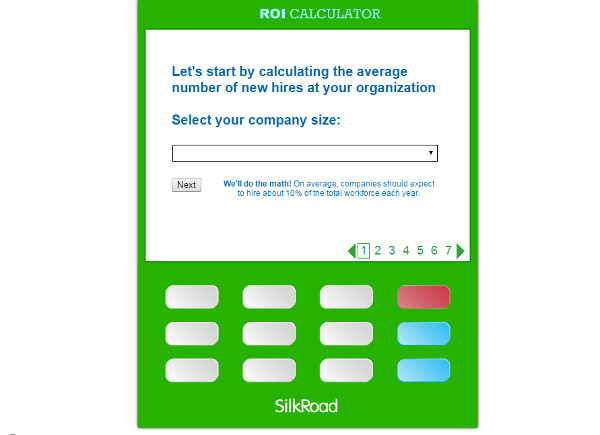
The result? Potential customers can clearly see the benefit of onboarding automation. This resulted in a boost in leads from the top to bottom of the funnel.
These are some very simple interactive content examples from the B2B marketing world. Using the tools available, along with some creativity, you can quickly create content that will get the attention of your market.
Tactic 2: Activity in LinkedIn Groups
Participating in LinkedIn Groups has always been an unpredictable B2B marketing tactic that’s for some marketers.
Sure, you can get great exposure and position yourself as an expert… but is it actually any good for lead generation?
The answer is yes, when done correctly. To do this, you first need to understand how groups work and why people get involved in them.
Most people join groups because they want to connect with other professionals and keep an ear to the ground of their industry.
There are many professionals that discuss their business challenges and share new ideas & content. Those who take their profession or business very seriously will want to be kept in the loop of certain developments.
This means that it’s a very effective channel for distributing your content and getting involved within a community around your industry. Here’s how we do it:
Step 1: Research Your Target LinkedIn Groups
Finding active LinkedIn groups related to your target market is easy. A quick search for “ecommerce” under the Group filter yields some good results:
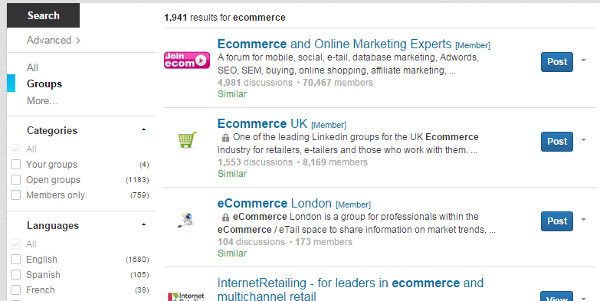
You want to find those with a large number of active members and discussions. You can go with your gut, but groups with at least 1,000 to 5,000 members are good candidates. 10,000+ members are ideal. “Ecommerce UK” from the list above looks like a good target.
Next, you want to see how active a group is. If there are thousands of members but nobody is saying anything then there’s no point in pursuing.
Underneath the group header, click on “Sort by” and select “Recent”. This will list discussions in chronological order, with the most recent at the top:
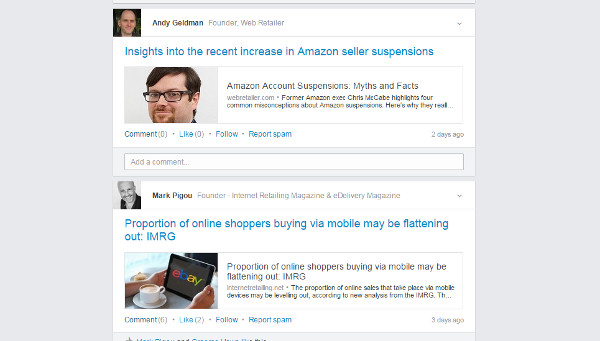
As you can see, there are a couple of discussions that were started in the last couple of days. Even the older discussions are still getting a lot of attention. This is definitely a good group to go for.
The final research step is to analyse what people are talking about. Go back to “Sort by” and click “Popular” to find out what the group members are most interested in.
When going through the group and its discussions, ask yourself these questions:
- Are there any ongoing discussions where you can add some insight?
- What challenges are being raised that you’ve covered in the content you already have?
- Are there any ideas for new content to create based on these discussions?
Each question present opportunities for connecting with the group audience, content distribution and the creation of tailored content.
Step 2: Get Involved
You see this bar on the right hand side of the group page?
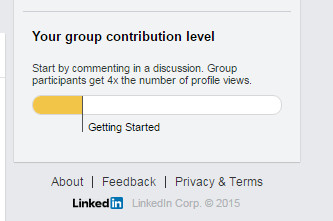
You want to build it up so it looks more like this:
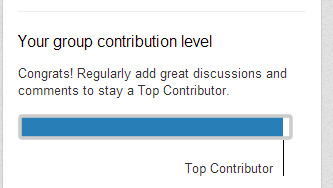
It’s an indicator that you’re a recognised member of your target LinkedIn group. Becoming recognised is an important step before asking the group audience to take some sort of action.
If you try and ask for something at this stage, it’s likely that it will be flagged as spam. You have no authority in the group and asking for something is obviously not going to work.
So you need to begin by contributing to discussions and providing value. Do this and you’ll become well known by the group members as a trustworthy source of information.
Although this may seem like it’ll take a long time to execute, it’s never taken me more than a week to become a top contributor. All you need to do is spend a week dipping into the group, providing valuable insight and responding to any further questions.
Pro tip: make your answers 2 to 4 paragraphs long. These get a lot more engagement and generate more attention.
It’s also worth starting a discussion of your own. Ask a question and gather some insight from other members. The more likes and comments you get the quicker you’ll be recognised as a “top contributor”, so make sure you talk about things people care about.
Step 3: Lead Generation Plan
Now you’ve got some authority within this group, it’s time to land some right hooks.
By this stage you should be well known by several members of the community. This will make distributing your content or getting in touch with potential leads a lot easier.
When sharing your content, try and position it around a discussion. Ask a question based on the topic of your content first. Then, once that discussion has gained some traction, include a link to your content in a separate comment:
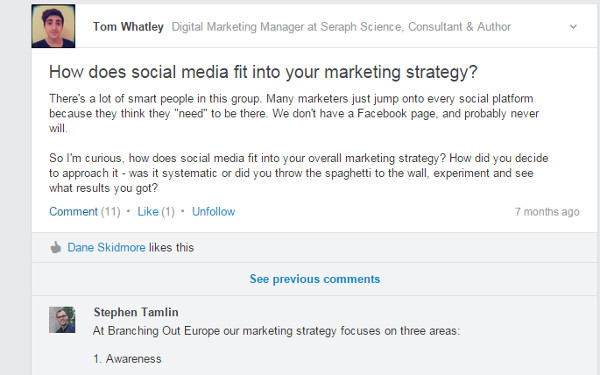
Not only will you have an audience ready for your content, who will get notified about it, but this will also keep group administrators happy.
Ideally, your chosen groups should be made up of members that make ideal prospects for your product or service offering.
Some of these prospects will be more active on the group than others. Those who are more active will likely recognise your name when you reach out to them.
As with all outreach efforts, make it super personal and position your call-to-action in a way that adds value to them. If you overdo it and spam members with messages you risk being flagged up to the group for promoting spam. If this happens you may lose your messaging rights to other group members.
The importance of this B2B marketing tactic lies in the first two stages. Finding the right group and getting involved within the community are key.
From there, tailor your approach based on your goals. When it comes to LinkedIn groups, content distribution and connecting with potential leads are two of the best you approaches can execute.
Tactic 3: Supercharged Guest Blogging
Here’s another one you may be familiar with, yet I bet you’re not executing it like this.
Most marketers, when creating guest posts for other publications, stick to a 500 to 1,000 word count.
What if we took this to 2,000, or even 4,000… what about 6,000 words?!
It’s no secret that longer blog posts perform best. Why don’t we transfer this over to the world of guest blogging? Here’s how:
Step 1: Find Ideas for Content People Actually Want
There’s no point in picking a topic that nobody wants to read about. We need to do a spot of research to discover the following two things:
- What topics are the audience interested in?
- What content based on those topics have done well in the past?
To do this, head over to the blog you want to guest post on and take a look at the categories. We’ll use the Optimizely Blog for this example:
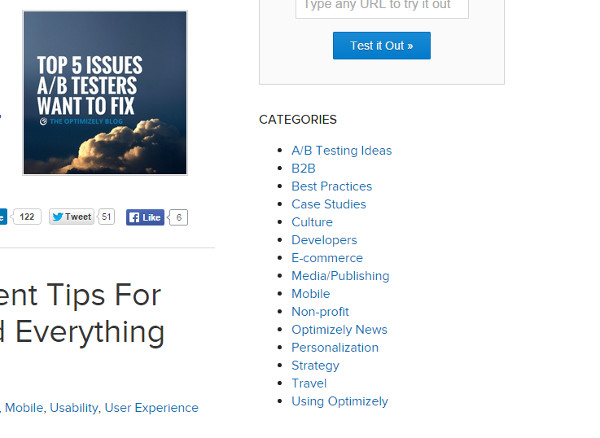
Make a list of these for later. Next, have a browse to see if they list their most popular posts and make a list of these.
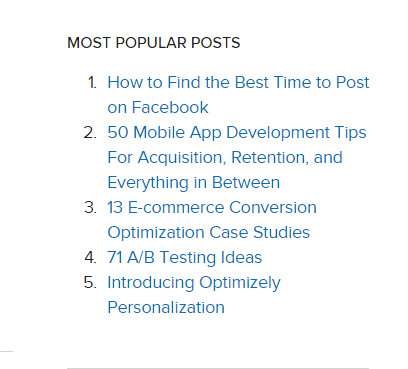
These two lists are a good start, but we’re marketers and we know how important metrics and data to back up our assumptions are. That’s why we’re going to use a tool called BuzzSumo.
BuzzSumo is a great tool for researching content based on keywords and domains. Based on these searches, you can find out how popular certain pieces of content are on social networks, as well as who shared them – great for distributing content later on.
Let’s start by typing in the URL of blog we want to guest post on:
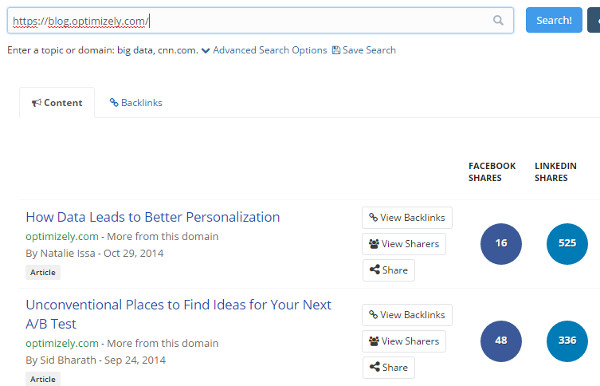
The free version only lets you see the first five results, but it’s worth investing in a monthly subscription if you’re serious about content marketing.
For now the five results will do. Take a note of the titles, topics and page URL’s of each.
Now you have a list of popular content, it’s time to analyse. Read through each post and see what they’ve done well, and what could be done better. Look out for the following:
- Gaps in the content that you can fill
- Common and unanswered questions in the comments section
- Content length – can you be more in-depth?
Obviously, you don’t want to take an already existing piece of content and re-do it. We’re looking for new content ideas based on what’s already done well.
Step 2: Create the Blog Post
Although you’re researching popular posts on your target blog, this doesn’t mean re-doing what’s already been done.
The idea here is to find topics that their audience is most passionate about, as well as any gaps that you can fill. From here you should choose a topic that will deliver a huge amount of value.
Blog post length is a big factor here. As I mentioned earlier, most people create posts that are 500 to 1,000 words in length when guest posting.
Hitting the 3,000 to 5,000 word mark with useful, actionable content will do three things:
- Increase shareability and drive more traffic to the guest post
- Make the audience of the guest publication love you and want to learn more
- Create a stronger relationship with the thought leaders behind the publication
If you get this right, you’ll get a lot of eyeballs on your guest post. That’s a lot of potential leads, so how do we increase conversions while keeping the thought leader you’re blogging for happy?
This is where the Content Upgrade comes in.
A Content Upgrade is basically an addition to the original content you created that readers can download in exchange for their email address or other details.
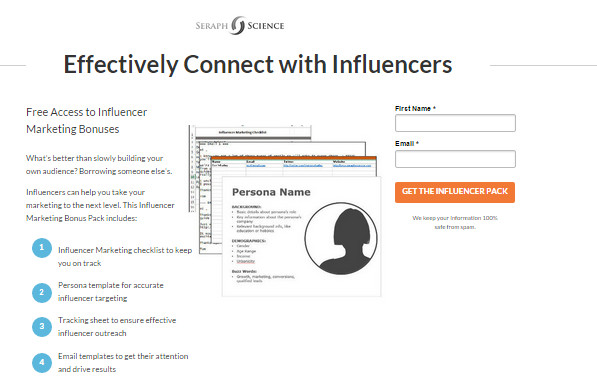
You can create a Content Upgrade in the form of:
- Extra content: Got a “5 ways to…” style post? Add point 6 and 7 in a free PDF
- Checklist: If you’re providing actionable strategies and techniques, include a checklist for readers to follow
- Tools & Templates: Give the resources people need to act upon what you’re teaching them
Traditionally you would lead visitors to a separate landing page, but publishers may not be happy for you to drive all their traffic to a separate page.
To get around this, you can use a tool such as LeadBoxes by LeadPages. This will allow you to create a “lightbox” style popup that will give them an opt-in box right on the page itself.
Doing this means you can collect leads, add extra value to the audience and keep the blogger happy that you won’t be cannibalising their traffic.
Step 3: Distribution
Now we’ve got a high-value piece of content, it’s time to drive traffic.
The publication in question will have its own distribution plan and email list, but it doesn’t hurt to put some extra effort in. Plus any thought leaders behind the publication will love you for it.
Let’s start by checking out who shared the popular posts you listed out in Step 1. Run each post through BuzzSumo and click on the “View Sharers” to view who shared the content through Twitter:

Again, the free version of BuzzSumo limits the number of results, but this should be enough to get you started.
Next, head over to Ahrefs, sign up for a free or paid account and enter the URL of the article you want to analyse. This tool will show you who has linked back to the article from their own content:
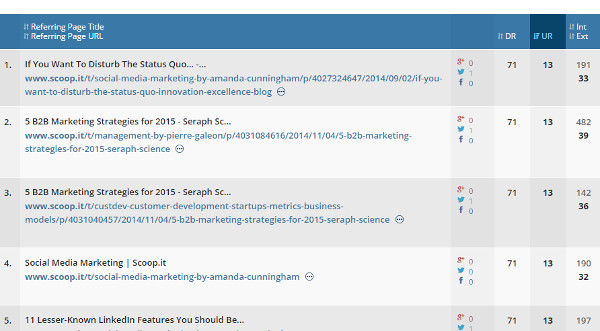
You can get to this section by clicking “Inbound Links” and then “Links”.
Now you have a list of sharers and linkers it’s time to reach out. Because they’ve shared content from the blog you’re guest posting on in the past then they’re going to be more receptive to sharing again. It’s a little warmer than a cold approach.
This is a super quick way to build a strong connection with another audience while cutting through the noise of guest posting.
Not only that, but by using a non-intrusive conversion mechanism like LeadBoxes you can quantify your efforts and generate leads in the process.
Tactic 4: Ad Targeting Specific Twitter Accounts
Social media marketing can contribute to several sales and marketing goals.
Sales enablement, connecting with influencers and potential SEO benefits all come to mind… but when it comes to Twitter there’s a lot of noise to cut through.
In the not-too-distant past, Twitter announced its ad platform was open to all users. This gave marketers a new paid acquisition channel to get their message in front of their target market, drive traffic and generate leads.
Like all things, the effectiveness of this channel started to decay and thus so did click-through-rates.
Here at Seraph Science, we’re fans of going deep instead of broad. This may not be the best approach for B2C marketers where quantity is as important as quality, but for us B2B marketers there’s an opportunity.
That opportunity lies in using ads to target specific Twitter accounts.
Let’s say you want to get the attention of a particular senior decision maker, thought leader or influencer. You could try emailing them cold… or you can deliver a specific message right into the platforms they use on a daily basis.
Here’s the thing with this B2B marketing tactic: because of the targeting, you risk coming across as creepy in your messaging.
In fact, this reminds me of the story of how one Brian Swichkow used Facebook’s custom audiences to prank his roommate. If you want a funny marketing story then this is it.
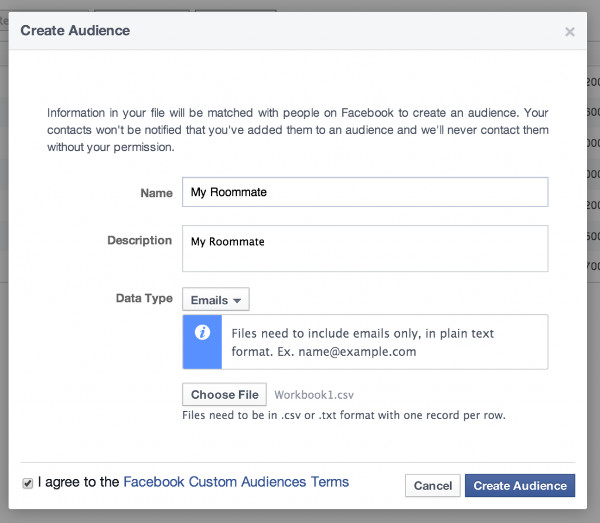
All entertainment aside, there’s a delicate balance in the B2B world and your message can come across as arrogant if you’re not careful.
You need to tailor the tone and approach of your message depending on the type of person you’re trying to target. As a B2B marketer, I can safely assume you’re either targeting influencers or potential clients. Here’s how to approach both:
Audience 1: Influencers
As I just mentioned, your message might come across as a bit arrogant if you’re not careful, but some influencers often appreciate something a bit daring and attention grabbing.
Like all marketing efforts, the tone of the message will depend on who you’re targeting. If your influencers are professional then use a professional tone. Likewise, if they’re laid back in nature then you have room to use a more personal tone.
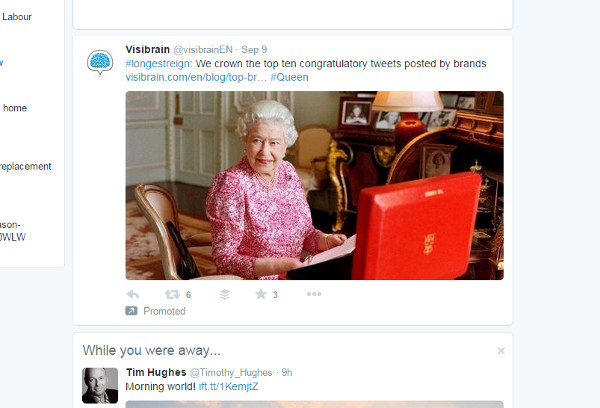
There are two approaches you can take to targeting influencers with Twitter ads.
The first is to target them singularly. By this, I mean tailoring a specific ad to a specific influencer.
This approach means you can be hyper personalised to their interests and position your message around their own cause. It may also be worth name-dropping but again, be careful with the creepy-factor.
The second approach is to create different campaigns around the content your influencers are interested in, or the topics that they closely align themselves with.
This is a slightly broader approach but allows you to scale. You’re still being specific with the targeting of your audience and messaging and is actually a preferred approach for many marketers.
Like any marketing effort, it’s important to test and measure the results, especially in the case of tough-to-crack influencers.
Audience 2: Potential Leads
The principles behind targeting this audience are similar to influencers. Instead of targeting broadly by demographic, you can target specific contacts that you’re interested in getting in front of.
One way of doing this is to create campaigns around specific personas. Say you’re targeting Head of Operations, COO’s and senior HR people in specific organisations. You can create a campaign for each of those roles and target your messaging accordingly.
Segmenting your campaigns by persona means serving top-of-funnel content that interests them the most. If you’ve not had much engagement with these individuals then you want to start at the top.
By creating content specific to each segmented audience, you’ll start to see increased CTRs in your campaigns, and your ad spend will be a lot lower due to how highly targeted you’re being.
Now you know of some different approaches, it’s time to set up a campaign. Check out this guide from HubSpot on how to get started with Twitter Ads.
Tactic 5: Create Simple Software
Towards the end of last year, I talked about how side-projects would be an effective B2B marketing strategy for this year.
This is still the case, but I want to talk specifically about how free software can act as a great lead generator for your organisation – also know as “engineering as marketing” in the growth hacker community.
This works similarly to interactive content, in that you’re delivering a huge amount of value in order to drive traffic, create massive amounts of awareness and, ideally, generate leads.
Instead of telling you how to do this, we’ll run through 3 great examples of engineering as marketing that have generated great results for their respective organisations.
HubSpot’s Marketing Grader
HubSpot’s co-founders, Dharmesh Shah and Brian Halligan, attribute a large amount of HubSpot’s success to this tool.
The Marketing Grader, previously known as the website grader, analyses your website’s marketing and ranks it, giving suggested improvements in the areas of SEO, social media, blogging and more.
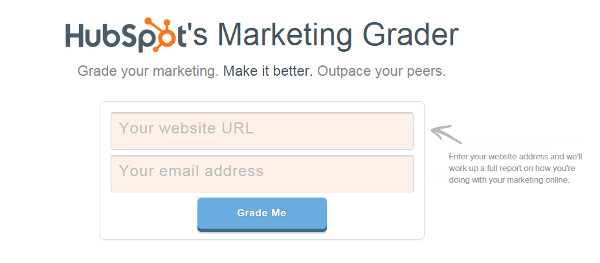
So far, the tool has graded more than 4 million websites and has been responsible for a huge amount of brand awareness. Lauren Pedigo, one of HubSpot’s APAC Marketing Managers, wrote:
“Since it launched in 2006, HubSpot’s award-winning free tool, Website Grader, graded more than 4 million websites. Website Grader gave marketers advice on how to improve many aspects of their websites and encouraged millions to bring their website presence to the next level, all for free. But a lot has changed since 2006, and these days, marketing is about much more than just your website.”
Dharmesh has been noted to say that this tool alone is responsible for a large portion of the 50,000+ leads HubSpot gets on a monthly basis.
They’ve also gone to make several other tools, such as the recent Make My Persona for fast buyer persona creation.
Query Mongo by RJ Metrics
This is a great example of a company finding and solving a very specific problem for their audience.
They noticed that their customers were having trouble converting MySQL queries into MongoDB. The language used by Mongo is more complicated than SQL and can be a pain to translate.
So they created Query Mongo as a SQL to Mongo translator. You simply enter your SQL code, click “Translate to Mongo” and voila! Your code is translated.
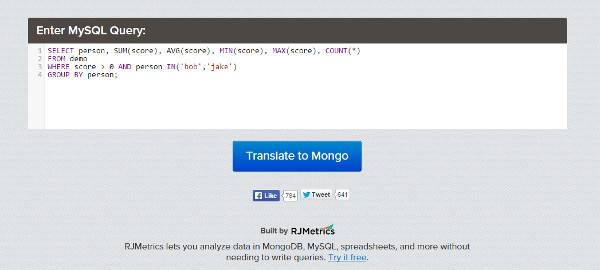
Query Mongo is one of RJMetrics’ biggest lead generation channels and is responsible for driving hundreds of leads a month.
Moz’s Open Site Explorer
Moz became a big player in the SEO world before ever launching a paid product, publishing lots of content and becoming thought leaders in that space.
Since then they’ve gone to launch a powerful SEO platform and several free tools for marketers, one of which being Open Site Explorer, or OSE for short.
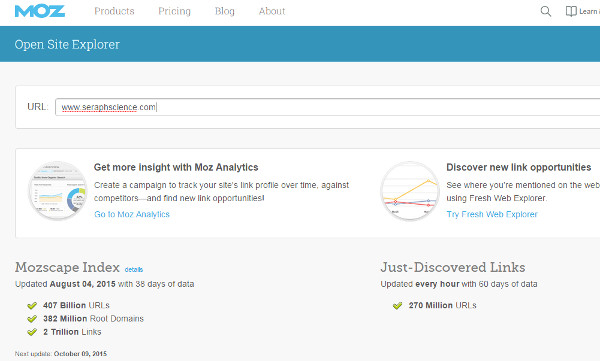
OSE allows you to analyse the off-page SEO of a webpage. You can see where a particular page is generating their inbound links, which is super powerful when doing SEO research.
Moz have also created other free tools, such as Followerwonk, which allows users to analyse their Twitter followers.
Why Do These Tools Generate Leads?
There are a couple of things that tie the three tools I’ve described above together.
The first is that they solve a specific problem that their personas are trying to overcome. These aren’t all-in-one solutions. They’re specific tools that, usually, have only one form of input; a URL, some code or another string of text.
It’s likely that these common problems were found from spending a lot of time with their target audience, and this is where you can get started.
What are some common problems your target market are trying to overcome that can be solved with simple software?
The best way to do this is by talking to your customers. Get talking to them face-to-face and find out what pet peeves they have around the jobs they do. You can also send out a survey for them to answer.
Secondly, they don’t let the information go to waste. Every user who types in their URL to HubSpot’s tool are a potential lead. They’ll investigate the company, see if they’re a fit and identify the right person to engage with.
In RJMetrics case, this is a little harder to quantify, so they’ll use re-marketing and calls-to-action within the Query Mongo page to re-activate lost users:

The key is this: solve a specific problem, give the solution away for free and then find ways to engage with the users who get the most value out of it. This is the key to success with engineering-as-marketing.
Conclusion
As you can see, one of the overarching values that connects these 5 B2B marketing tactics is that they are all built on a value-giving foundation.
In other words, if you’re not doing something to add value to your target audience, or trying to solve their problems, then you’re not doing it right.
Another connecting factor is that, as the B2B marketing world gets noisier, you’re going to need to be more focused with your targeting. That means being very laser-focused with your targeting and your message.
The good news is that there’s a lot of opportunity on the table for those who are willing to spend the time to really connect and engage with their audience in a deep and meaningful way. The more you can show you care about your audience the more they’ll give back to you.
Interested in more effective B2B marketing tactics? I’ve created a PDF with two more.
Click the image below to download it for free:
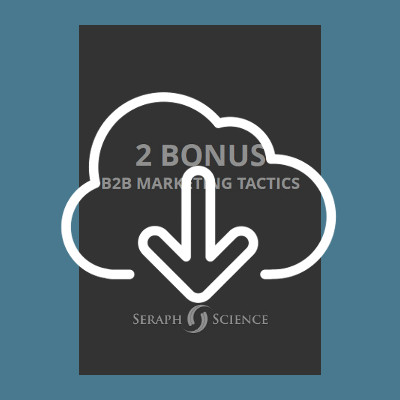



Pingback:The Journey From 121 to 1,016 List Subscribers - More leads for your dev shop
Posted at 17:42h, 25 September[…] Content upgrades on blog articles on https://philipmorganconsulting.com. I think I’ll start with the top 25% by traffic. Here’s a great example of a content upgrade. […]
Pingback:5 B2B Marketing Tactics for Effective Lead Gene...
Posted at 10:41h, 13 November[…] There are many new B2B marketing tactics to test, but which are worth focusing your attention on? Here are 7 innovative techniques that are working now. […]
cheap basketball jerseys
Posted at 18:19h, 16 JuneThank you a lot for sharing this with all folks you actually understand what you’re speaking approximately!
Bookmarked. Kindly also talk over with my site =).
We will have a hyperlink alternate arrangement between us https://www.liveinternet.ru/users/m1iwamu543/post470620105// http://athenac4.bling.fr/2020/mai/22/144552/super-bowl-prediction-colonial-vs-n-y.html http://forum-tanya-jawab-lanterha-kuningan.88850.x6.nabble.com/Scott-McKenna-td660.html
Here is my blog cheap basketball jerseys
James Harris
Posted at 19:37h, 22 JuneKind words, kemosabe